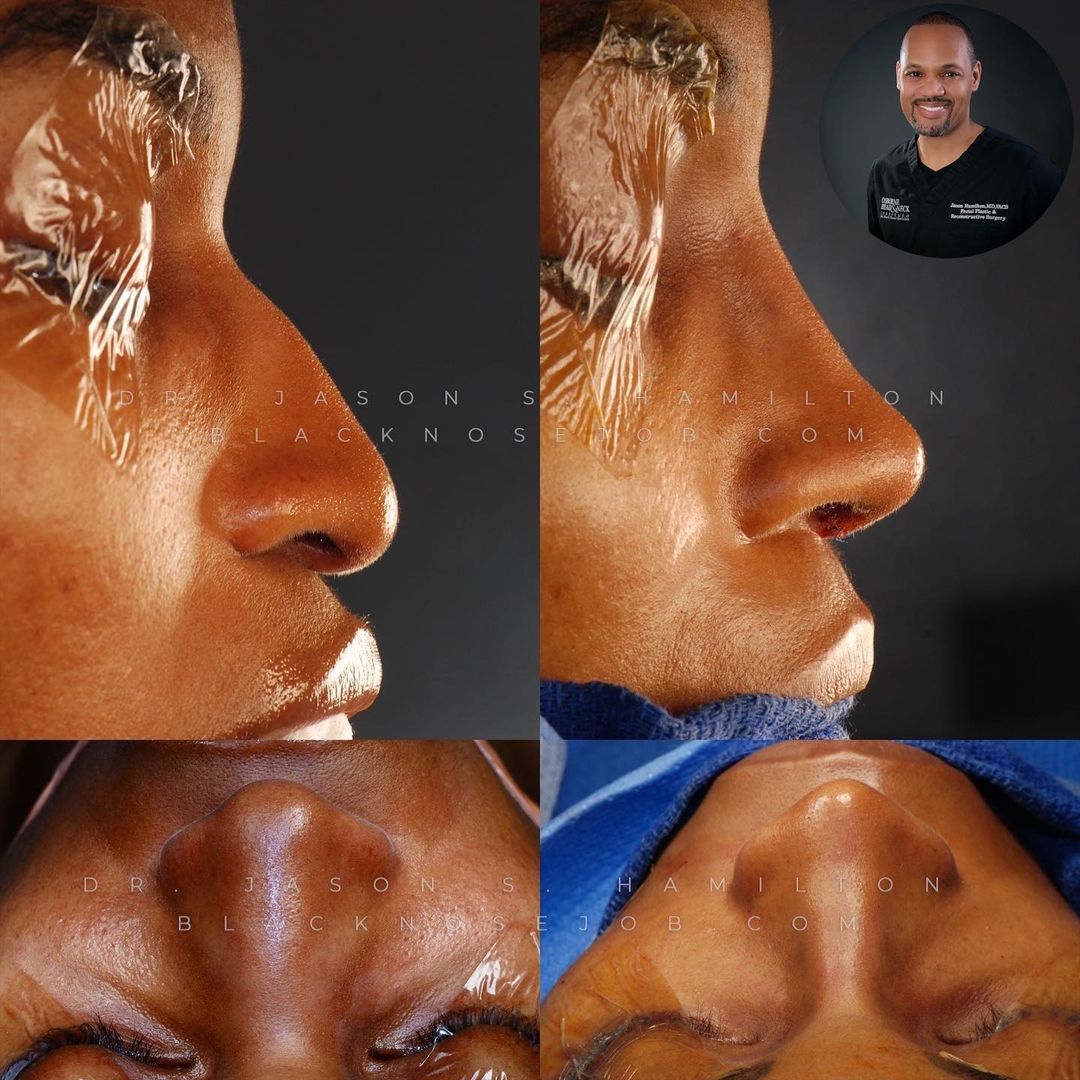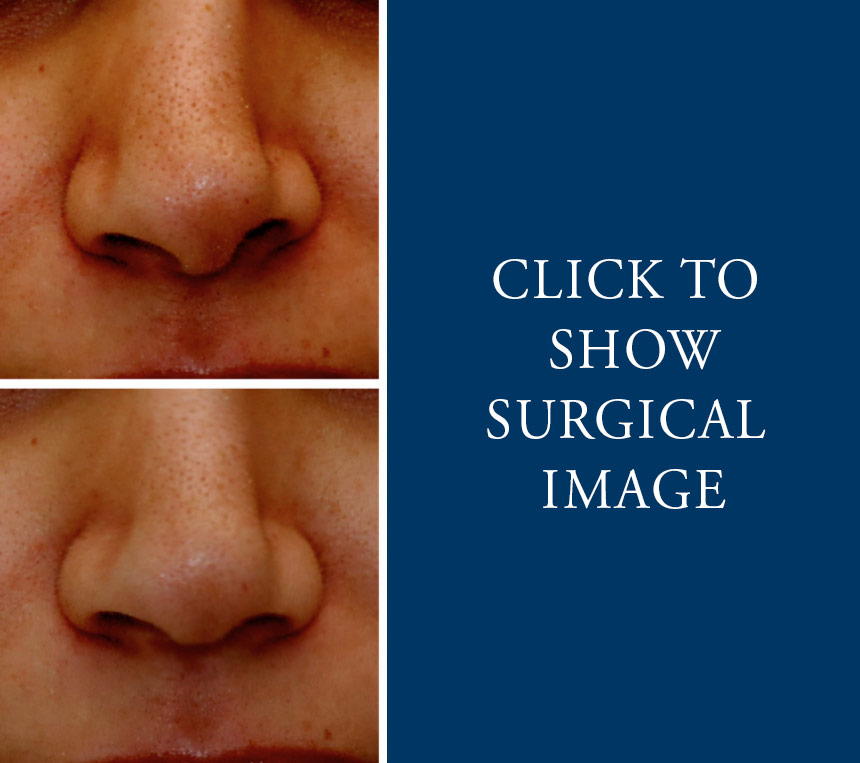
LOS ANGELES, CA
Ethnic Rhinoplasty
Why consider rhinoplasty?
Every year in the United States, millions of people seek consultation with a plastic surgeon to discuss their options for improving the appearance of their nose. Approximately 10-15% of those patients are African Americans and this number is on the rise.
African American noses come in all shapes and sizes and an individual’s personal reasons for getting rhinoplasty vary as much. Some African Americans are unhappy with the noses they were born with, and some initially happy with their nose have noticed changes to the shape of their nose as they have aged. For others, a sports injury or accident may have distorted the nose and they simply want their old nose back. Sometimes the goal is simply improved breathing. One thing is clear: the size and shape of the nose has a significant impact on how a person feels about their face. The nose is the most defining characteristic of the face, and a slight alteration can greatly improve one’s overall appearance.
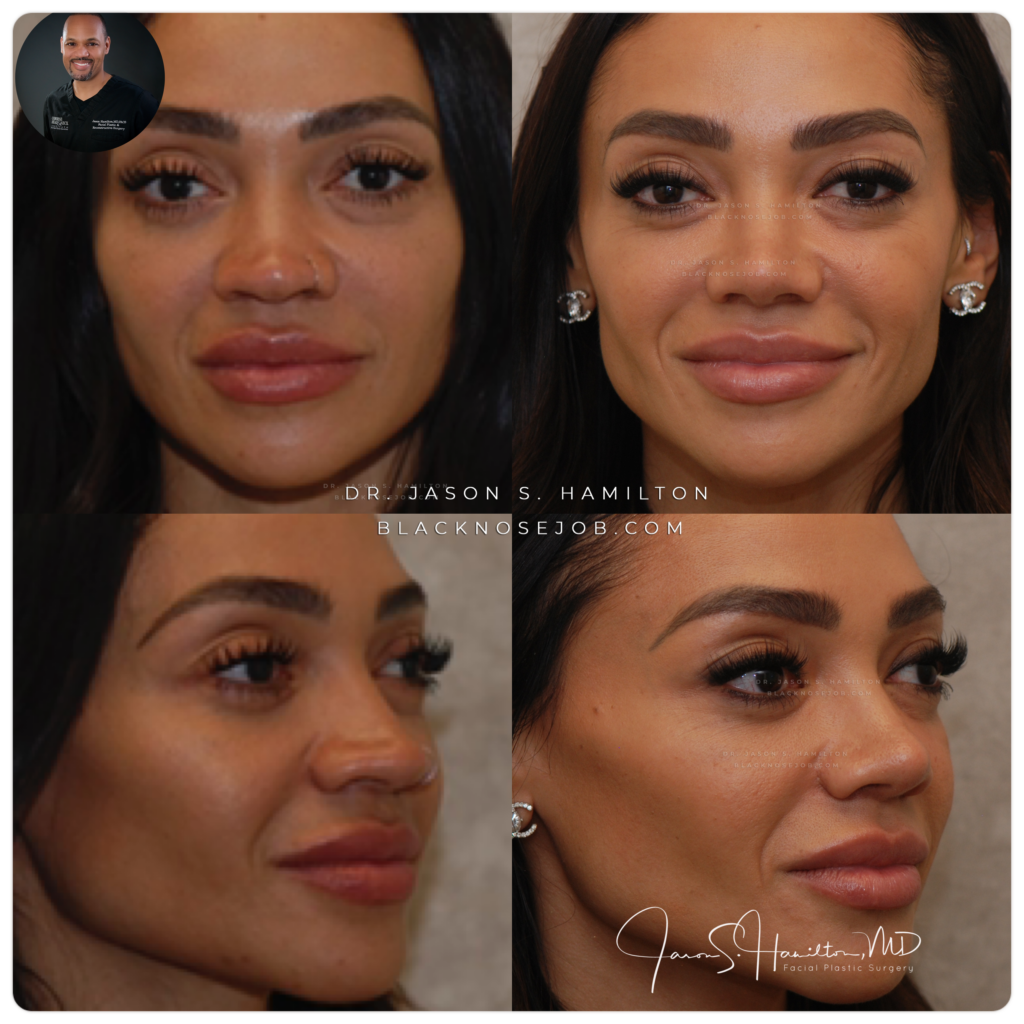
What is Ethnic Rhinoplasty?
Many plastics surgeons, in an effort to capitalize on the growth of rhinoplasty in the black community, promote themselves as specializing in “ethnic rhinoplasty”. Ethnic rhinoplasty is a catchall term that groups all patients who are not Caucasian, be it African American, Asian, Hispanic, Indian etc. into one big super group the “ethnic”. So we now have oversimplified the individual and created two groups for rhinoplasty, the Caucasian and the “Ethnic” rhinoplasty (which places everyone else in the world into one category). The term “ethnic” rhinoplasty is problematic for two reasons; 1) it is used to lump everyone who is not Caucasian into one category and does not appreciate the patient as an individual and 2) the term “ethnic”or ethnicity relates to cultural factors such as nationality, ancestry, language and beliefs and is not appropriate when discussing differences in an individuals anatomy that may come into play when performing rhinoplasty.
“Truly, there is no such thing as an “ethnic rhinoplasty”. Similarly, there is no such thing as a Caucasian rhinoplasty.
There is only rhinoplasty, catered to the individual, which is subtle, addresses a patient’s specific concerns and above all else appears natural and in harmony with the patient’s face and race.”
-Dr. Hamilton
cosmetic rhinoplasty
Cosmetic rhinoplasty is performed on individuals who want to change the appearance of their nose and have no functional deficits (i.e. deviated septum) or history of traumatic injury (broken nose). This is what the public would refer to as a rhinoplasty in the traditional sense. For African Americans the areas most commonly target for change by patients are the:
- Wide Nasal Ala – wide nasal ala, more commonly referred as the nostrils, are the most common area of concern for African American patients. Traditionally, performing excisions of the nostril skin to reduce the flare of the nostrils and make them appear smaller has been the standard approach to reduce wide nostrils in the African American rhinoplasty patient. This simple approach however often leads to an operated look and in most cases the nostrils take on an upside down V appearance instead of the naturalcurve of an un-operated nostril. Dr. Hamilton prefers to strategically reshape the entire nostril and not simply rely on skin excisions to adequately address wide nostrils in the African American rhinoplasty patient. This has allowed him to achieve superior results in reforming the nostril in African American patients.
Dr. Hamilton’s method reshapes the entire nostril leading to superior results vs. the standard procedure, which relies on skin excisions and leads to an over operated look.
- Wide Nasal Tip – thinning and reshaping the cartilage in the lower third of the nose typically addresses a wide and bulbous nasal tip lobule. Sometimes cartilage is borrowed (cartilage grafts) to help add structure and support to the tip of nose, giving it more definition. For the African American patient seeking rhinoplasty, Dr. Hamilton, has designed his own modified procedure to achieve superior results, which do not rely solely on excessive cartilage grafting. Cartilage grafts can leave the nose stiff and unnatural in appearance and are seldom the right option for patients who want a natural appearing nose.
Dr. Hamilton’s method leaves the nasal tip with a natural refinement, which never looks over operated.
- Nasal Dorsum – Wide Low Hump. African American patients seeking rhinoplasty often complain about the “bridge” of the nose being to wide, low or both. Many surgeons agree and attempt to narrow the nose by performing osteotomies to “break” the nose and narrow the bridge. Dr. Hamilton rarely performs standard osteotomies in African American seeking rhinoplasty because this often over narrows the nose, makes the tip appear even larger and leads to an unnatural appearance after surgery.
Dr. Hamilton’s method to address a wide or low dorsum does not rely on osteotomies to refine the dorsum of the nose. Dr. Hamilton is able to achieve the same results without osteotomies in most cases.
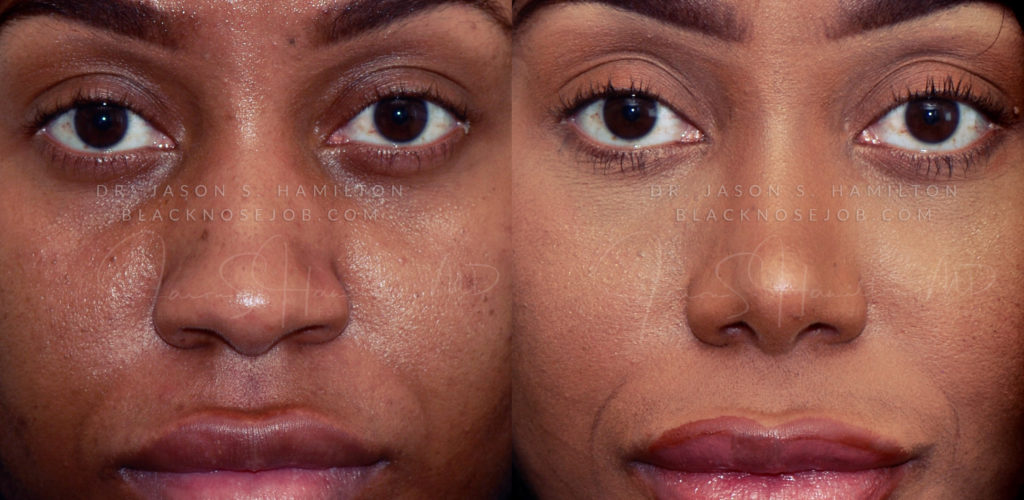
rhinoplasty
How is rhinoplasty performed?
First, small incisions are made inside the nose and the cartilage and bony support system of the nose is accessed. The majority of incisions are made inside the nose, where they are invisible. In some cases, an incision is made in the area of skin separating the nostrils. This incision is invisible when healed and leaves no visible scar. All unwanted deformities are outlined and marked for reshaping. Next, the underlying bone and cartilage are reshaped, added to, or rearranged to provide a newly shaped nose.
Dr. Hamilton uses special techniques that he has designed specifically for rhinoplasty patients who are African American that allow him to achieve excellent result for his patients. The soft tissues that cover the nasal bones and cartilage are then redraped over the new framework, sutured in place to prevent swelling postoperatively, and finally the incisions are closed. A splint is applied to the outside of the nose to help retain the new shape of the new nose while the patients heals. Soft, absorbent material may be used inside the nose as a nasal dressing. No packing is ever used. Occasionally soft splints that permit breathing post-operatively are placed. Recovery is 5-7 days. See below for recovery after your rhinoplasty procedure. Most of the swelling associated with cosmetic rhinoplasty is gone within the first two weeks and the nose continues to refine itself for several months after the procedure looking better and better each day.
Deciding on cosmetic rhinoplasty can be an exciting time for patients. Dr. Hamilton is always available to educate you on all aspects of the procedure and recovery period. After deciding a rhinoplasty is right for you, make sure to ask Dr. Hamilton about any additional procedures that he may recommended to enhance/ and or balance the appearance of your nose and face. The most requested procedure is chin augmentation. Approximately ten percent of African Americans having rhinoplasty will benefit from chin augmentation to balance the face and nasal profile. It is in no way a mandatory procedure and can always be performed as a second procedure under local anesthesia or with a mild sedative if you decide later that you would like to have a chin augmentation.
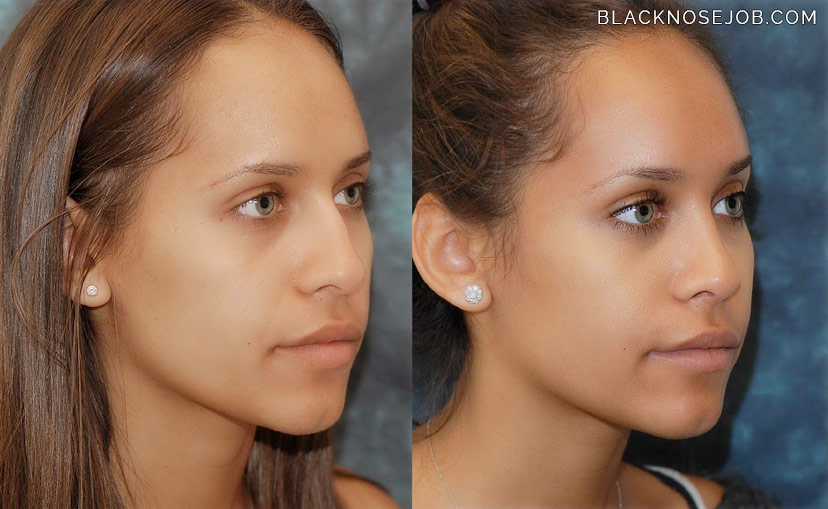
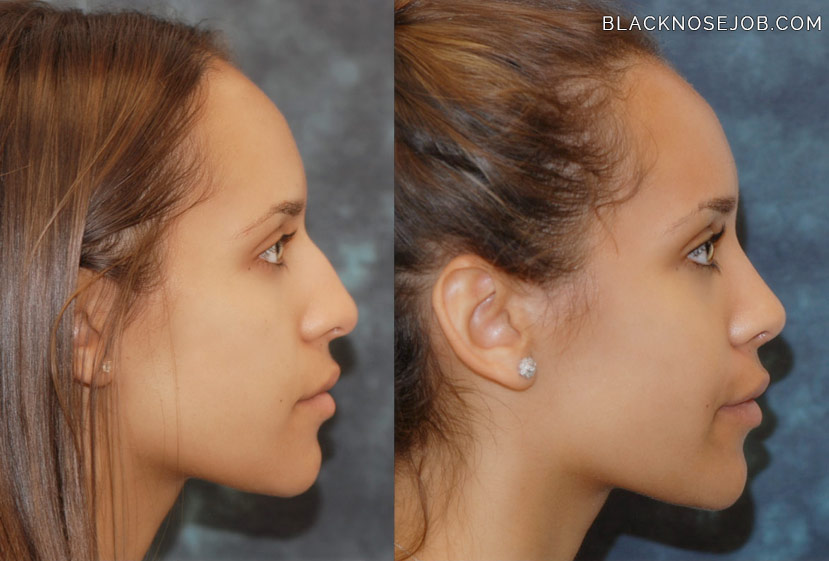
rhinoplasty and facial symmetry: balancing face, nose, and chin
One of the most important elements to a well-balanced profile is harmony between the nose and chin. Aesthetic facial proportions are most balanced when the forehead, nose, and chin make up equal thirds of the face. A micrognathic (under projected) or microgenic (small) chin makes the upper face and nose dominate the facial profile. Balancing the face with a chin implant can help to balance a patient’s profile. Rhinoplasty results can also be enhanced in situations where the chin is poorly projected, making the nose appear larger than it really is. It is important when considering a chin implant/ chin augmentation that it is always done conservatively so the chin is not over projected, becoming overbearing and dominating the facial profile. The gross majority of patients do not require a chin implant. If you are interested in chin augmentation please discuss it with Dr. Hamilton at your consultation.
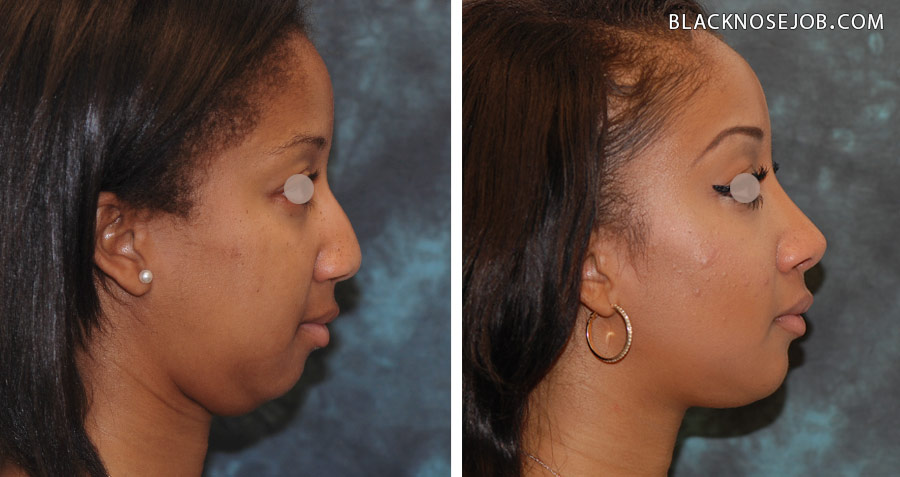
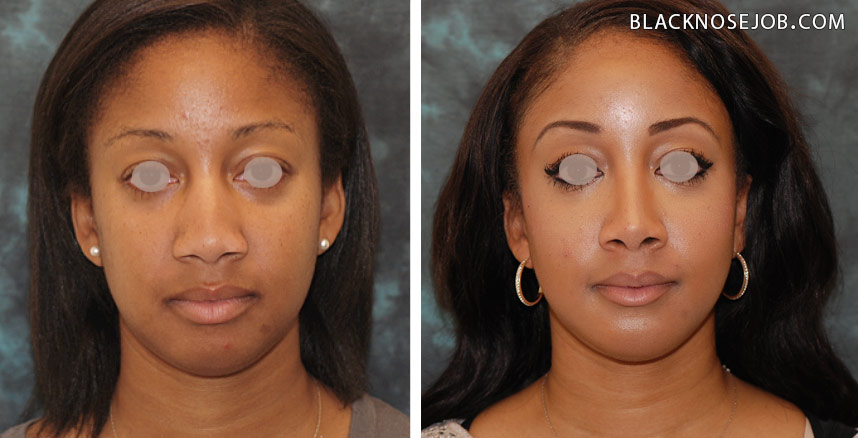
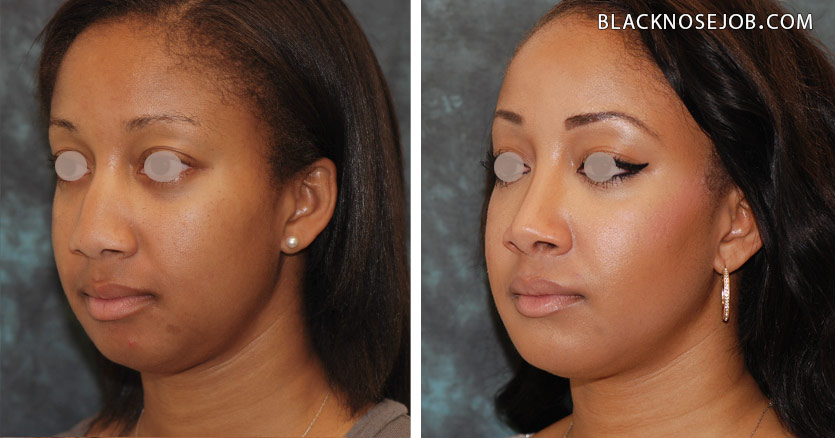
Revision rhinoplasty
Many people who have undergone a cosmetic rhinoplasty may be unhappy with the aesthetic and/or functional results of their procedure, and seek revision rhinoplasty to correct their problem. Poor results can occur as a result of a complicated case (i.e. traumatic broken nose), an inexperienced surgeon (physician skilled in rhinoplasty but not for African American patients), or simply due to patients healing poorly. Revision rhinoplasty, also known as secondary rhinoplasty, is a complicated procedure that is most successfully performed by a rhinoplasty specialist to reshape or resize the nose after an initial procedure. Some of the problems patients complain of after their initial rhinoplasty procedure include:
- Breathing difficulties #1 complication
- Over-narrowing/ pinched tip (cloths-pin deformity)
- Retracted or flared nostrils
- Creases from collapse around the nostrils
- Scooped out profile (sky jump deformity)
- Twisted tip
- Deviated dorsum or septum
- Perforated septum
These problems can range from subtle imperfections to severe deformities. It is important to choose a highly skilled surgeon who specializes in revision surgery in order to achieve your desired results during the secondary procedure. Dr. Hamilton strives to help patients achieve the highest level of satisfaction from their rhinoplasty and will do his best to produce the results the patient desires.
Candidates for Revision Rhinoplasty
Anyone who is unhappy with the results of their initial rhinoplasty procedure may be a candidate for revision rhinoplasty. Patients should discuss their initial procedure with either their original surgeon or a different one in order to determine the new goals for revision. It is also important for patients to be both emotionally and financially prepared for additional surgery.
Dr. Hamilton will determine whether or not revision surgery is a possibility for you after discussing your goals for surgery and performing a physical examination. The examination will focus on the functional aspects of your nose first and then aesthetic concerns. In the majority of cases fixing the functional problems of the nose improves the aesthetic appears as well.
Revision Rhinoplasty Procedure
The revision rhinoplasty procedure is usually performed on an outpatient basis under deep sedation or general anesthesia to help reduce any potential discomfort. Revision rhinoplasty is usually performed using an open technique, allowing for greater visualization of the nasal cavity because the already-reshaped bone and cartilage may be more difficult to sculpt with a closed technique. Again the open technique has only a small incision between the nostrils with all other incisions inside the nose. This incision heals with no visible scar. In difficult cases, a cartilage graft from the nasal septum, ear or rib may be required. In some cases injectable fillers may be used to correct minor irregularities after primary rhinoplasty. In most cases the patient’s own native cartilage is the preferred material. The entire procedure usually takes about three hours, which is a little longer than a primary rhinoplasty.
Figures: Revision Rhinoplasty – the first surgery on this patient (performed elsewhere) was successful in narrowing the tip and bridge of the nose however the postoperative results show a twisted dorsum and nasal tip. Intraoperative photos show the twisted cartilage before and after repair. Note the postoperative result shows a straight dorsum and nasal tip and significant improvement from her first procedure.
Recovery from Revision Rhinoplasty
After the revision rhinoplasty procedure, patients will usually experience bruising and swelling for five to seven days. Initial results of the revision procedure will not be noticeable right away, but will continue to improve as swelling subsides and the nose heals. It is important for patients to remember that a revision rhinoplasty heals slowly. Swelling may take longer to subside than a primary rhinoplasty and the final results may not be fully visible for one to two years. Noticeable improvement however will be apparent shortly after surgery.
Risks and Complications
Revision rhinoplasty carries the same risks associated with primary rhinoplasty however the procedure is more difficult to execute. It is important for patients to understand the risks associated with revision rhinoplasty and to maintain realistic expectations for their revision rhinoplasty. The best results are achieved by choosing a highly skilled and experienced surgeon to perform your revision surgery, and by maintaining open communication.
functional rhinoplasty- the broken nose
Projecting prominently from the central part of the face, it is no surprise that the nose is the most commonly broken bone on the head. A broken nose (nasal fracture) can significantly alter your appearance. It can also make it much harder to breathe through the nose.
What is a nasal fracture?
Getting struck on the nose, whether by another person, a door, or the floor is not pleasant. Your nose will hurt—usually a lot. You’ll likely have a nose bleed and soon find it difficult to breathe through your nose. Swelling develops both inside and outside the nose, and you may get dark bruises around your eyes (“black eyes”). Nasal fractures can affect both bone and cartilage. A collection of blood (called a “septal hematoma”) can sometimes form on the nasal septum (a wall made of bone and cartilage inside the nose that separates the nose into two sides).
What causes a nasal fracture?
Nasal fractures, or broken noses, result from facial injuries in contact sports or falls. Injuries affecting the teeth and mouth may also affect the nose.
When should I see a doctor?
If you’ve been struck in the nose, it’s important to see a physician to check for septal hematoma. Seeing your primary doctor or an Emergency Room physician is usually adequate to determine if you have a septal hematoma or other associated problems from your accident. If a septal hematoma is present, it must be treated promptly to prevent worse problems from developing in the nose. If you suspect your nose may be broken, see an otolaryngologist—head and neck surgeon within one week of the injury. If you are seen within one to two weeks, it may be possible to repair your nose immediately. If you wait longer than two weeks (one week for children) you will likely need to wait several months before your nose can be surgically straightened and fixed. If left untreated, a broken nose can leave you with an undesirable appearance as well as permanent difficulty with breathing.
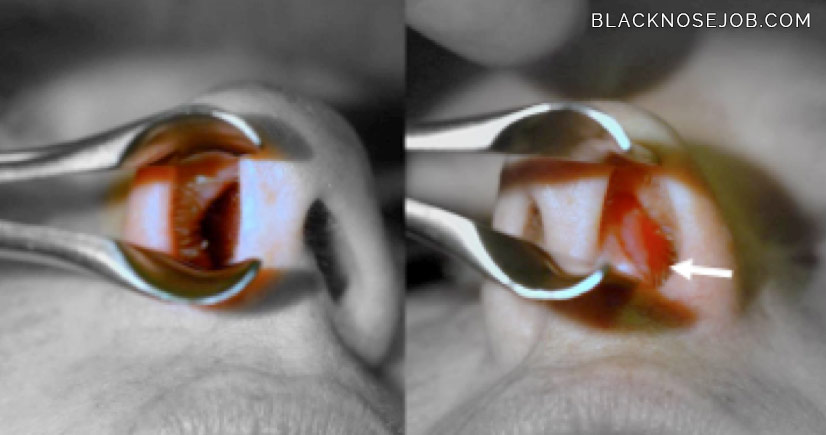
How will Dr. Hamilton determine if I have a broken nose?
Dr. Hamilton will ask you several questions and will examine your nose in detail. You will be asked to explain how the fracture occurred, your general state of health, and how your nose looked before the injury. Bring photographs of yourself with you to the consultation if possible. The most useful views will be portrait and profile views. At a minimum bring your drivers license with you as this usually has a good head on photo. During your physical exam Dr. Hamilton will also examine the surrounding areas of your nose including the eyes, forehead, jaw, and teeth. He will also look for bruising, lacerations, and swelling that may signal hidden injuries. Sometimes Dr. Hamilton will recommend an x-ray or computed tomography (CT) scan if he believes you may have hidden injuries. These can help to identify other facial fractures but are not always helpful in determining if you have a broken nose. The best way to determine if your nose is broken is by physical exam.
What are my treatment options within 2 weeks of injury?
Dr. Hamilton will evaluate the nose immediately after the injury and at five days. At this time the swelling has subsided significantly and Dr. Hamilton can get a more accurate picture of how your nose originally looked. If your nose is broken but not out of position, you may need no treatment at all. Simply rest and avoiding further trauma may be all that is needed. If your nose needs to be repositioned, the bones are mobile and easily repositioned at this point. Reduction of the fracture is performed in the operating room under general anesthesia, which yields the best results. In rare cases simple fractures can be repositioned in the office under local anesthesia with a mild sedative. A cast is placed outside the nose in both cases and removed in 5 days.
What if I need surgery but it has been more than 2 weeks?
Early repair takes place within two weeks of the initial injury and is a simple procedure. If more than two weeks have passed since the time of your initial injury, you may need to wait before having your nose straightened. This would be considered a late repair. After 2-3 weeks the nasal bones are very difficult to manipulate as they have started to heal. In this case delayed repair maybe the best option. In this scenario you may need to wait three to six months before a repair can be performed, at which time the swelling will have resolved and the nasal bones will be relatively healed. This surgery is considered reconstructive surgery, and the goal is to restore your nose to its natural appearance and function prior to the injury.
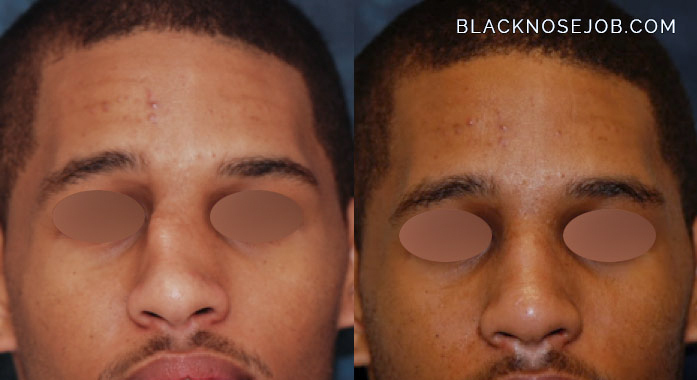
rhinoplasty recovery
What to Expect After Surgery
Cast/ splints – Immediately after surgery, a small splint supported by tape will be placed on the outside of your nose to protect it from injury, minimize swelling and keep the new structure stable for five days. The splint does not shape the new nose it is merely there for your protection.
Packing – Nasal packing can be very uncomfortable for patients in the postoperative period therefore Dr. Hamilton does not use any packing in the nose after rhinoplasty surgery. Traditionally, packing has been used to stabilize the nose after surgery and prevent bleeding. Dr. Hamilton performs rhinoplasty in a manner that avoids the use of painful packing.
Your face and nose will feel puffy the first few days after surgery this is normal. In the immediate days following surgery, you may experience bruising and minor swelling in the eye area. Cold compresses often reduce the bruising and discomfort. Pain medication may be required and will be prescribed. An antibiotic is also typical prescribed for the first five days after surgery.
At your post operative appointment all dressings/splints/casts and any nonabsorbable sutures will be removed. Nasal dressings and splints are usually removed five days after surgery. Dr. Hamilton will then discuss with you how to speed up the healing process in the upcoming weeks. It is crucial that you follow all of Dr. Hamilton’s directions to achieve the best results from surgery and have a smooth recovery.
Some activities will be restricted in the weeks after the procedure. This is to insure you achieve the best results from surgery and speed the recovery process. Sun exposure, over-exertion, and contact sports must be avoided. If you wear glasses, special instructions will be given to ensure that the glasses do not rest on the bridge of the nose. If you wear contacts, this is a great time to use them.
Follow-up care is vital for this procedure to monitor healing. Obviously, anything unusual should be reported to your surgeon immediately. It is essential that you keep any follow-up appointments with Dr. Hamilton. Three month and one year follow-up appointments for out-of-town patients are typically done via video conference. For local patients and those who travel follow-up is done in office.
Insurance
Insurance companies do not cover surgery cost for procedures that are purely for cosmetic reasons. Surgery to correct or improve nasal function or surgery for a major deformity or injury may be reimbursable in whole or in part. We can assist you with preauthorization, coverage limits and determining your out-of-pocket cost before any procedure.
MEET Dr. Hamilton. IN-OFFICE & VIDEO
APPOINTMENTS AVAILABLE
